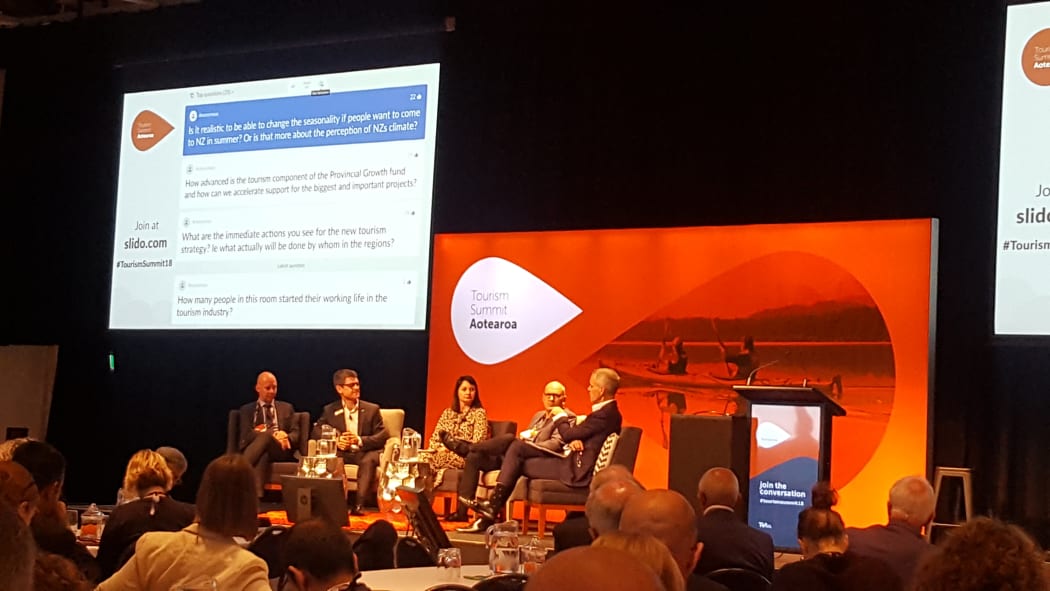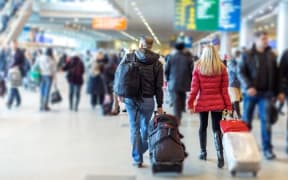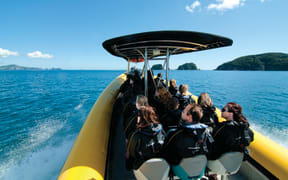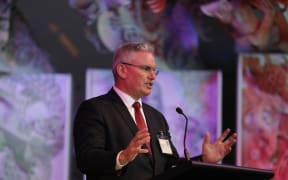With more than half of the multi-billion tourist dollars staying in airport gateway cities, some regions are feeling short changed.

The panel at the annual Tourism Summit Aotearoa in Wellington this morning. Photo: RNZ / Tess Brunton
Industry leaders were cruching the numbers at the Tourism Summit Aotearoa in Wellington today, to see how remote tourist attractions can get a better slice of the pie and entice visitors away from the main centres.
It's all part of the discussion around the industry's 2025 growth strategy.
The industry is worth an estimated $38 billion.
Government figures show 65 percent of all international tourist dollars don't leave the main gateways of Auckland, Christchurch, Wellington, Dunedin and Queenstown.
Venture Southland tourism and event manager Warrick Low said lack of spending put regions in a bit of a pickle.
"It's a bit of a chicken and an egg situation really, because to attract people you've got to have the infrastructure ... to invest in the infrastructure, you've got to have people and people come for attractions," Mr Low said.
That could become problematic when visitors had limited time to spend in the country, he said.
Mr Low said collaboration was fundamental in attracting visitors to the regions.
"Tourism and tourists don't see boundaries, and we're too small and too fragmented to work individually and we really can't be competing with each other. We've got to be working together and then getting the opportunites of scale."
Tourism Waitaki general manager Margaret Munro said with so many attractive options for tourists, it could be hard for remote hotspots to find their competitive advantage.
She said that was where small to medium-sized tourism operators came in - but it could be hard for them to survive.
"There's a whole business aspect behind the small-medium businesses in tourism that there's not even a conversation going on about [it] at this stage. But they are the coal face of tourism, they are going to grow the industry."
Tourism Bay of Plenty chief executive Kristin Dunne spoke on a leaders panel about the future of tourism.
She said the fact that tourist spending was focused on the big cities meant they could be a victim of their own success.
"What we're feeling from a government funding perspective at the moment is that if you're doing too well or seem to be too wealthy, then the investment isn't there or the funding isn't there and it's going to other more remote areas," Ms Dunne said.
"But actually the more remote areas are never going to survive unless their regional hub is functioning really well."
The government's new plan for the tourism industry has a heavy focus on sustainability.
Tourism Industry Aotearoa chief executive Chris Roberts said that meant sharing the spending and tourists across the regions.
It's not that the regions aren't growing - in the past four to five years, the industry has grown by $10b, and each region has benefitted from that boom.
However, Mr Roberts said there was more to be done to ensure the regions hold their market share.
"In an ideal world, we'd like to see steady growth in the main tourism centres and spectacular growth in the region so they can start sharing a bigger piece of the pie," he said.
But it was a mistake to be too idealistic about just how many tourists the regions could draw from those population centres, Mr Roberts said.
"There are some must dos in every destination and New Zealand is no different."
The industry's 2025 growth strategy is expected to be finalised by March.






